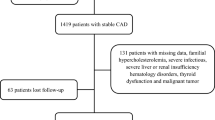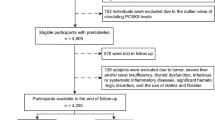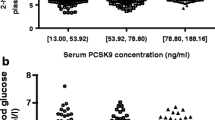Abstract
Purpose
It has been reported that proprotein convertase subtilisin/kexin type 9 (PCSK9) inhibitors can significantly reduce lipoprotein(a) [Lp(a)], and the mechanism for Lp(a) reduction remains unclear. Recently an interesting clinical research with a small sample showed a positive correlation between plasma PCSK9 and Lp(a) levels in diabetes. Here we aimed to use a relatively large sample to investigate whether such an association exists in Han Chinese.
Methods
A total of 783 inpatients were consecutively enrolled and composed of 172 patients with type 2 diabetes mellitus (T2DM) and 611 non-T2DM subjects. Plasma PCSK9 level was measured by ELISA, and its association with Lp(a) was assayed by Spearman’s correlation and multiple regression. Clinical and biochemical parameters were determined in all subjects studied.
Results
No significant differences in PCSK9 and Lp(a) levels were found between T2DM and non-T2DM patients. PCSK9 level was not related to Lp(a) level either in T2DM or non-T2DM group in bivariate correlation and multiple linear regression analysis. Additionally, no association between the levels of PCSK9 and Lp(a) was found in well, poorly controlled T2DM patients or in T2DM patients with or without coronary artery disease (CAD). Besides, no difference was found among the PCSK9 values across tertiles of Lp(a) level.
Conclusion
We found no association of plasma PCSK9 levels with Lp(a) level in Han Chinese with or without T2DM, suggesting that Lp(a) reduction by PCSK9 inhibitors may not be achieved simply through PCSK9 pathway at least in Chinese.




Similar content being viewed by others
Abbreviations
- PCSK9:
-
Proprotein convertase subtilisin/kexin type 9
- Lp(a):
-
Lipoprotein(a)
- T2DM:
-
Type 2 diabetes mellitus
- CAD:
-
Coronary artery disease
- ASCVD:
-
Atherosclerotic cardiovascular disease
- LDL-C:
-
Low-density lipoprotein cholesterol
- HDL-C:
-
High-density lipoprotein cholesterol
- TG:
-
Triglycerides
- LDL-R:
-
Low-density lipoprotein receptor
- Apo:
-
Apolipoprotein
- Hs-CRP:
-
High-sensitivity C-reactive protein
- BMI:
-
Body mass index
- OADs:
-
Oral anti-diabetic drugs
- HbA1c:
-
Glycated hemoglobin
References
Lamon-Fava S, Diffenderfer MR, Marcovina SM (2014) Lipoprotein(a) metabolism. Curr Opin Lipidol 25(3):189–193
Nordestgaard BG, Chapman MJ, Ray K et al (2010) Lipoprotein(a) as a cardiovascular risk factor: current status. Eur Heart J 31(23):2844–2853
Kassner U, Schlabs T, Rosada A, Steinhagen-Thiessen E (2015) Lipoprotein(a)—an independent causal risk factor for cardiovascular disease and current therapeutic options. Atheroscler Suppl 18:263–267
Genser B, Dias KC, Siekmeier R, Stojakovic T, Grammer T, Maerz W (2011) Lipoprotein (a) and risk of cardiovascular disease—a systematic review and meta analysis of prospective studies. Clin Lab 57(3–4):143–156
Norata GD, Ballantyne CM, Catapano AL (2013) New therapeutic principles in dyslipidaemia: focus on LDL and Lp(a) lowering drugs. Eur Heart J 34(24):1783–1789
Seidah NG, Benjannet S, Wickham L et al (2003) The secretory proprotein convertase neural apoptosis-regulated convertase 1 (NARC-1): liver regeneration and neuronal differentiation. Proc Natl Acad Sci USA 100(3):928–933
Maxwell KN, Breslow JL (2004) Adenoviral-mediated expression of Pcsk9 in mice results in a low-density lipoprotein receptor knockout phenotype. Proc Natl Acad Sci USA 101(18):7100–7105
Abifadel M, Varret M, Rabes JP et al (2003) Mutations in PCSK9 cause autosomal dominant hypercholesterolemia. Nat Genet 34(2):154–156
Seidah NG, Awan Z, Chretien M, Mbikay M (2014) PCSK9: a key modulator of cardiovascular health. Circ Res 114(6):1022–1036
Almontashiri NA, Vilmundarson RO, Ghasemzadeh N et al (2014) Plasma PCSK9 levels are elevated with acute myocardial infarction in two independent retrospective angiographic studies. PLoS One 9(9):e106294
Li S, Zhang Y, Xu RX et al (2015) Proprotein convertase subtilisin-kexin type 9 as a biomarker for the severity of coronary artery disease. Ann Med 47(5):386–393
Desai NR, Kohli P, Giugliano RP et al (2013) AMG145, a monoclonal antibody against proprotein convertase subtilisin kexin type 9, significantly reduces lipoprotein(a) in hypercholesterolemic patients receiving statin therapy: an analysis from the LDL-C assessment with proprotein convertase subtilisin kexin type 9 monoclonal antibody inhibition combined with statin therapy (LAPLACE)-thrombolysis in myocardial infarction (TIMI) 57 trial. Circulation 128(9):962–969
Raal FJ, Giugliano RP, Sabatine MS et al (2014) Reduction in lipoprotein(a) with PCSK9 monoclonal antibody evolocumab (AMG 145). J Am Coll Cardiol 63(13):1278–1288
Romagnuolo R, Scipione CA, Boffa MB, Marcovina SM, Seidah NG, Koschinsky ML (2015) Lipoprotein(a) catabolism is regulated by proprotein convertase subtilisin/kexin type 9 through the low density lipoprotein receptor. J Biol Chem 290(18):11649–11662
Nekaies Y, Baudin B, Kelbousi S, Sakly M, Attia N (2015) Plasma proprotein convertase subtilisin/kexin type 9 is associated with Lp(a) in type 2 diabetic patients. J Diabetes Complications 29(8):1165–1170
Li S, Guo Y-L, Xu R-X et al (2014) Association of plasma PCSK9 levels with white blood cell count and its subsets in patients with stable coronary artery disease. Atherosclerosis 234(2):441–445
Zhang Y, Zhu C-G, Xu R-X et al (2014) Relation of circulating PCSK9 concentration to fibrinogen in patients with stable coronary artery disease. J Clin Lipidol 8(5):494–500
Lambert G, Ancellin N, Charlton F et al (2008) Plasma PCSK9 concentrations correlate with LDL and total cholesterol in diabetic patients and are decreased by fenofibrate treatment. Clin Chem 54(6):1038–1045
Wassef H, Bissonnette S, Saint-Pierre N et al (2015) The apoB-to-PCSK9 ratio: a new index for metabolic risk in humans. J Clin Lipidol 9(5):664–675
Cui Q, Ju X, Yang T et al (2010) Serum PCSK9 is associated with multiple metabolic factors in a large Han Chinese population. Atherosclerosis 213(2):632–636
Li S, Xu RX, Zhang Y et al (2015) Relation of resistin to proprotein convertase subtilisin-kexin type 9 levels in coronary artery disease patients with different nutritional status. J Endocrinol Invest 38(12):1291–1299
Lakoski SG, Lagace TA, Cohen JC, Horton JD, Hobbs HH (2009) Genetic and metabolic determinants of plasma PCSK9 levels. J Clin Endocrinol Metab 94(7):2537–2543
ADA (2003) Report of the expert committee on the diagnosis and classification of diabetes mellitus. Diabetes Care 26 (Supp l):S5–S20
Taskinen MR (2003) Diabetic dyslipidaemia: from basic research to clinical practice*. Diabetologia 46(6):733–749
Wu L, Parhofer KG (2014) Diabetic dyslipidemia. Metabolism 63(12):1469–1479
Vergès B, Duvillard L, Brindisi MC et al (2011) Lack of association between plasma PCSK9 and LDL-apoB100 catabolism in patients with uncontrolled type 2 diabetes. Atherosclerosis 219(1):342–348
Brouwers MCGJ, Troutt JS, van Greevenbroek MMJ et al (2011) Plasma proprotein convertase subtilisin kexin type 9 is not altered in subjects with impaired glucose metabolism and type 2 diabetes mellitus, but its relationship with non-HDL cholesterol and apolipoprotein B may be modified by type 2 diabetes mellitus: the CODAM study. Atherosclerosis 217(1):263–267
Chen J, Zhang Y, Liu J et al (2015) Role of lipoprotein(a) in predicting the severity of new on-set coronary artery disease in type 2 diabetics: a Gensini score evaluation. Diabetes Vasc Dis Res 12(4):258–264
Boronat M, Saavedra P, Pérez-Martín N, López-Madrazo MJ, Rodríguez-Pérez C, Nóvoa FJ (2012) High levels of lipoprotein(a) are associated with a lower prevalence of diabetes with advancing age: results of a cross-sectional epidemiological survey in Gran Canaria, Spain. Cardiovasc Diabetol 11(1):81
Mora S, Kamstrup PR, Rifai N, Nordestgaard BG, Buring JE, Ridker PM (2010) Lipoprotein(a) and risk of type 2 diabetes. Clin Chem 56(8):1252–1260
Srinivasan SR, Dahlen GH, Jarpa RA, Webber LS, Berenson GS (1991) Racial (black-white) differences in serum lipoprotein (a) distribution and its relation to parental myocardial infarction in children. Bogalusa Heart Study. Circulation 84(1):160–167
Kappelle PJWH, Lambert G, Dahlbäck B, Nielsen LB, Dullaart RPF (2011) Relationship of plasma apolipoprotein M with proprotein convertase subtilisin–kexin type 9 levels in non-diabetic subjects. Atherosclerosis 214(2):492–494
Cariou B, Le Bras M, Langhi C et al (2010) Association between plasma PCSK9 and gamma-glutamyl transferase levels in diabetic patients. Atherosclerosis 211(2):700–702
Baass A, Dubuc G, Tremblay M et al (2009) Plasma PCSK9 is associated with age, sex, and multiple metabolic markers in a population-based sample of children and adolescents. Clin Chem 55(9):1637–1645
Costet P, Hoffmann MM, Cariou B, Guyomarc’h Delasalle B, Konrad T, Winkler K (2010) Plasma PCSK9 is increased by fenofibrate and atorvastatin in a non-additive fashion in diabetic patients. Atherosclerosis 212(1):246–251
Sahebkar A, Simental-Mendía LE, Guerrero-Romero F, Golledge J, Watts GF (2015) Effect of statin therapy on plasma PCSK9 concentrations: a systematic review and meta-analysis of clinical trials. Diabetes Obes Metab. doi:10.1111/dom.12536:n/a-n/a
Araki S, Suga S, Miyake F et al (2014) Circulating PCSK9 levels correlate with the serum LDL cholesterol level in newborn infants. Early Hum Dev 90(10):607–611
Qi Q, Workalemahu T, Zhang C, Hu FB, Qi L (2011) Genetic variants, plasma lipoprotein(a) levels, and risk of cardiovascular morbidity and mortality among two prospective cohorts of type 2 diabetes. Eur Heart J 33(3):325–334
Yeang C, Witztum JL, Tsimikas S (2015) ‘LDL-C’ = LDL-C + Lp(a)-C. Curr Opin Lipidol 26(3):169–178
Squier TC (2001) Oxidative stress and protein aggregation during biological aging. Exp Gerontol 36(9):1539–1550
Tsimikas S, Hall JL (2012) Lipoprotein(a) as a potential causal genetic risk factor of cardiovascular disease: a rationale for increased efforts to understand its pathophysiology and develop targeted therapies. J Am Coll Cardiol 60(8):716–721
Besseling J, Kastelein JJP, Defesche JC, Hutten BA, Hovingh GK (2015) Association between familial hypercholesterolemia and prevalence of type 2 diabetes mellitus. JAMA 313(10):1029
Ye Z, Haycock PC, Gurdasani D et al (2014) The association between circulating lipoprotein(a) and type 2 diabetes: is it causal? Diabetes 63:12
Ding L, Song A, Dai M et al (2015) Serum lipoprotein (a) concentrations are inversely associated with T2D, prediabetes, and insulin resistance in a middle-aged and elderly Chinese population. J Lipid Res 56(4):920–926
Miao J, Manthena PV, Haas ME, Ling AV, Shin D-J, GM J (2015) Role of insulin in the regulation of proprotein convertase subtilisin/kexin type 9. Arterioscler Thromb Vasc Biol 35:1589–1596
Acknowledgments
This work was partially supported by the National Natural Science Foundation of China (81070171, 81241121), the Specialized Research Fund for the Doctoral Program of Higher Education of China (20111106110013), the Capital Special Foundation of Clinical Application Research (Z121107001012015), the Capital Health Development Fund (2011400302), and the Beijing Natural Science Foundation (7131014) awarded to Dr. Jian-Jun Li, MD, PhD.
Author information
Authors and Affiliations
Corresponding author
Ethics declarations
Conflict of interest
The authors have no conflict of interests.
Ethical approval
The authors state that they have obtained appropriate institutional review board approval or have followed the principles outlined in the Declaration of Helsinki for all human or animal experimental investigations.
Informed consent
Informed consent has been obtained from all individual participants included in the study.
Rights and permissions
About this article
Cite this article
Yang, SH., Li, S., Zhang, Y. et al. Analysis of the association between plasma PCSK9 and Lp(a) in Han Chinese. J Endocrinol Invest 39, 875–883 (2016). https://doi.org/10.1007/s40618-016-0433-9
Received:
Accepted:
Published:
Issue Date:
DOI: https://doi.org/10.1007/s40618-016-0433-9




